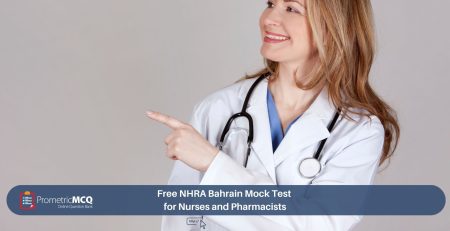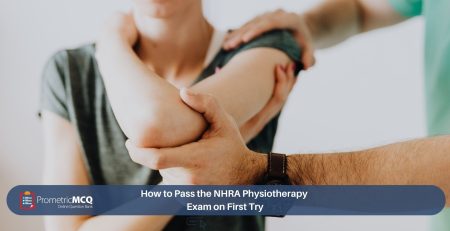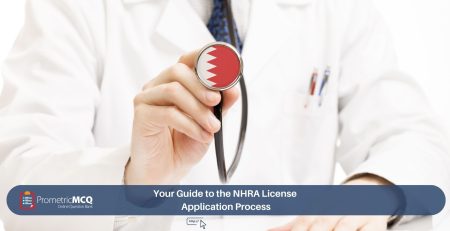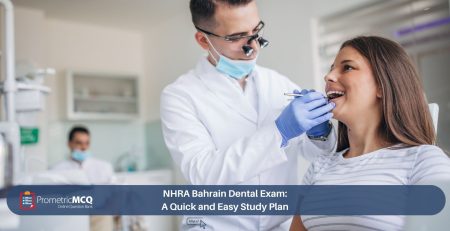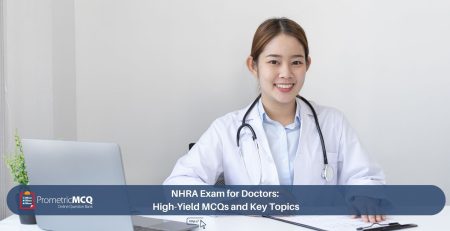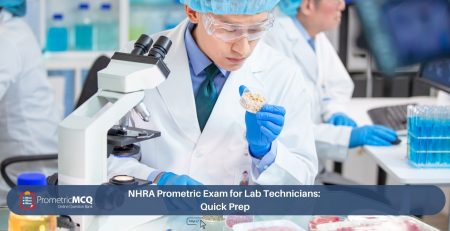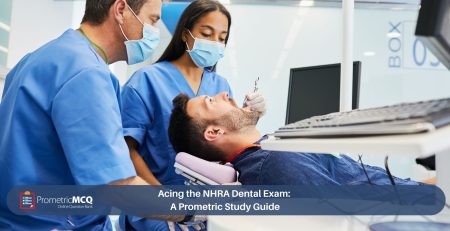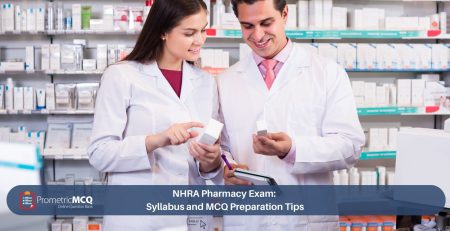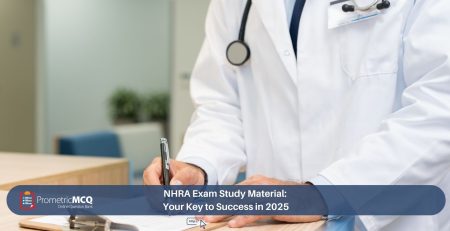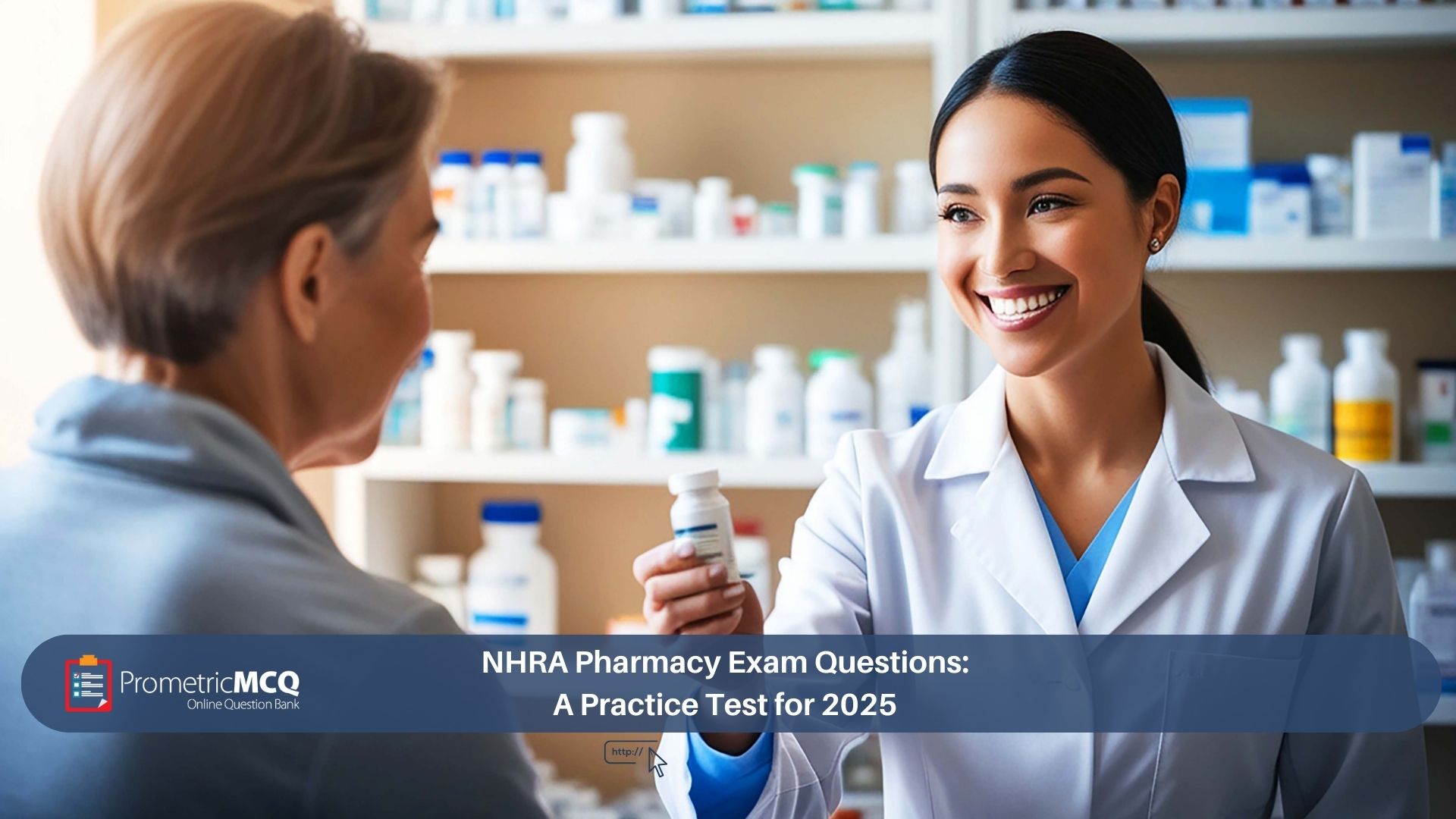
NHRA Pharmacy Exam Questions: A Practice Test for 2025
fatima@prometricmcq.com2025-09-19T01:54:31+00:00Table of Contents
ToggleNHRA Pharmacy Exam Questions: A Practice Test for 2025
For pharmacists seeking to advance their careers in the dynamic and highly regulated healthcare environment of the Kingdom of Bahrain, the National Health Regulatory Authority (NHRA) licensure exam is the definitive rite of passage. This comprehensive examination is meticulously designed to ensure that every pharmacist possesses the clinical knowledge, technical skills, and understanding of local laws necessary to provide safe and effective patient care. Success on the NHRA exam is less about memorizing drug names and more about applying deep pharmacological principles to solve complex, real-world clinical and dispensing scenarios.
The most powerful tool in any candidate’s preparation arsenal is the practice test. Engaging with high-quality, exam-style Multiple-Choice Questions (MCQs) is the key to transforming passive knowledge into active, applicable skill. A well-designed practice test does more than just gauge your current knowledge; it trains your clinical reasoning, improves your time management, and exposes the specific, high-yield topics that are most likely to appear on the actual exam.
This ultimate 2025 guide has been created to serve as your definitive practice resource. We will provide a comprehensive mock test composed of high-yield NHRA pharmacy exam questions, each with a detailed, explanatory rationale. This guide also includes a breakdown of the exam’s core domains and a robust 10-point FAQ section to address all your logistical and strategic questions. Our goal is to provide you with a realistic exam experience that builds both knowledge and confidence, setting you on a clear path to success.
Key Takeaways for the NHRA Pharmacy Exam
- Three Pillars of Knowledge: The exam is built on Clinical Pharmacy, Pharmaceutical Sciences, and, crucially, Bahrain Pharmacy Law & Practice.
- Calculations Must Be Flawless: Expect numerous questions on dosage calculations, dilutions, and pharmacokinetics. 100% accuracy is required.
- Clinical Scenarios are King: Most questions will be case-based, requiring you to choose the best drug, identify an interaction, or counsel a patient.
- Know Local Laws: Questions about dispensing controlled substances, prescription validity, and other Bahrain-specific regulations are a significant and unique part of the exam.
- Practice is Paramount: The single most effective study method is to actively solve hundreds of MCQs and analyze the rationales for both correct and incorrect answers.
Simulating the Real Exam: The NHRA Pharmacy Exam Pattern
Before attempting the practice test, it’s essential to understand the framework of the actual exam. This knowledge is a core part of your overall Bahrain NHRA exam preparation.
- Format: Computer-Based Test (CBT) administered at a Prometric center.
- Questions: 150 Multiple-Choice Questions (MCQs).
- Duration: 3 hours (180 minutes).
- Scoring: Pass/Fail result, with no negative marking. The unofficial pass mark is around 60%.
NHRA Pharmacy Exam Practice Test (2025)
This mock test contains 15 high-yield questions designed to reflect the style, content, and difficulty of the real NHRA exam. Take your time, read each question carefully, and select the single best answer. The detailed rationales that follow are the most valuable part of this exercise.
Question 1: Clinical Pharmacy (Cardiology)
A 68-year-old patient with a history of heart failure (LVEF 30%) and chronic kidney disease (eGFR 25 mL/min/1.73m²) is being treated with furosemide, lisinopril, and carvedilol. He presents with new-onset gynecomastia. Which of the following medications, if added to his regimen for heart failure, is the most likely cause of this side effect?
- Sacubitril/Valsartan
- Spironolactone
- Dapagliflozin
- Hydralazine
Question 2: Pharmaceutical Calculations
You are asked to prepare a 1-liter bag of 0.45% Sodium Chloride solution using a stock solution of 10% Sodium Chloride and Sterile Water for Injection. How many milliliters of the 10% NaCl stock solution are required?
- 4.5 mL
- 45 mL
- 90 mL
- 100 mL
Question 3: Pharmacology (Endocrinology)
A patient with type 2 diabetes is prescribed metformin. Which of the following is the primary mechanism of action of this drug?
- Increases insulin secretion from pancreatic beta cells
- Decreases glucose absorption in the small intestine
- Decreases hepatic glucose production
- Increases glucose reabsorption in the proximal renal tubules
Question 4: Pharmacy Practice & Law
According to Bahrain’s pharmacy regulations, a prescription for a narcotic medication (e.g., Morphine) is typically valid for how long from the date it is written?
- 3 days
- 7 days
- 30 days
- 90 days
Question 5: Clinical Pharmacy (Infectious Diseases)
A patient is prescribed oral vancomycin. Which of the following infections is this medication intended to treat?
- Methicillin-resistant Staphylococcus aureus (MRSA) pneumonia
- Clostridioides difficile colitis
- Vancomycin-resistant Enterococcus (VRE) urinary tract infection
- Streptococcal pharyngitis
Question 6: Pharmaceutics
Which of the following excipients is added to a tablet formulation to promote its breakup into smaller particles upon contact with gastrointestinal fluid?
- Lubricant (e.g., Magnesium stearate)
- Binder (e.g., Starch paste)
- Glidant (e.g., Colloidal silicon dioxide)
- Disintegrant (e.g., Croscarmellose sodium)
Question 7: Pharmacology (Adverse Drug Reactions)
A patient taking an ACE inhibitor like lisinopril should be counseled about a persistent, dry cough. This side effect is primarily mediated by an increase in the levels of which substance?
- Angiotensin II
- Aldosterone
- Bradykinin
- Renin
Question 8: Clinical Pharmacy (Gastroenterology)
A patient is diagnosed with H. pylori-positive peptic ulcer disease. Which of the following is a standard first-line triple therapy regimen?
- Omeprazole, Metronidazole, and Tetracycline
- Omeprazole, Clarithromycin, and Amoxicillin
- Ranitidine, Bismuth subsalicylate, and Amoxicillin
- Pantoprazole, Ciprofloxacin, and Clindamycin
Question 9: Pharmaceutical Calculations
A physician orders an intravenous infusion of a drug at a rate of 20 mg/hour. The pharmacy provides a solution containing 500 mg of the drug in 250 mL of D5W. At what rate in mL/hour should the infusion pump be set?
- 5 mL/hr
- 10 mL/hr
- 15 mL/hr
- 20 mL/hr
Question 10: Pharmacy Practice & Counseling
When dispensing a prescription for oral bisphosphonates like alendronate, what is the most critical counseling point to provide to the patient to ensure safety and efficacy?
- Take the medication with a large glass of milk to prevent stomach upset.
- Lie down for at least 30 minutes after taking the medication.
- Take the medication on an empty stomach with a full glass of water and remain upright for at least 30 minutes.
- Take the medication immediately after a heavy meal to improve absorption.
Answers & In-Depth Rationales
Rationale for Question 1:
Correct Answer: B (Spironolactone)
Rationale: Spironolactone is a mineralocorticoid receptor antagonist (MRA) and a cornerstone therapy in HFrEF. However, it is non-selective and also blocks androgen receptors and inhibits testosterone synthesis, which can lead to endocrine side effects like gynecomastia (enlargement of breast tissue in males), decreased libido, and menstrual irregularities. Given the patient’s presentation, this is the most likely causative agent.
Distractors:
A: Sacubitril/Valsartan (an ARNI) does not have gynecomastia as a common side effect.
C: Dapagliflozin (an SGLT2 inhibitor) is not associated with gynecomastia.
D: Hydralazine is a vasodilator and is not associated with gynecomastia.
Rationale for Question 2:
Correct Answer: B (45 mL)
Rationale: This is an alligation or C1V1=C2V2 calculation.
Using C1V1 = C2V2:
C1 (Concentration of stock) = 10%
V1 (Volume of stock) = ?
C2 (Final concentration) = 0.45%
V2 (Final volume) = 1000 mL
(10%) * V1 = (0.45%) * (1000 mL)
10 * V1 = 450
V1 = 450 / 10 = 45 mL.
Distractors: The other options are incorrect calculations.
Rationale for Question 3:
Correct Answer: C (Decreases hepatic glucose production)
Rationale: Metformin, a biguanide, is the first-line agent for type 2 diabetes. Its primary mechanism of action is to decrease gluconeogenesis (the production of glucose) in the liver. It also improves insulin sensitivity in peripheral tissues (like muscle) and slightly decreases glucose absorption from the gut, but its main effect is on the liver.
Distractors:
A: This describes sulfonylureas (e.g., glipizide).
B: This is a secondary effect of metformin, but not the primary one.
D: This describes SGLT2 inhibitors (e.g., dapagliflozin), which *inhibit* glucose reabsorption, causing glucosuria.
Rationale for Question 4:
Correct Answer: A (3 days)
Rationale: In the Kingdom of Bahrain, regulations for controlled substances are very strict to prevent misuse. Prescriptions for narcotic drugs are highly controlled and have a very short validity period to ensure the patient is re-evaluated frequently. The standard validity for a narcotic prescription is only 3 days from the date of writing.
Distractors: The other options represent longer validity periods that typically apply to non-controlled or semi-controlled medications.
Rationale for Question 5:
Correct Answer: B (Clostridioides difficile colitis)
Rationale: Vancomycin is a large glycopeptide antibiotic that is not absorbed from the gastrointestinal tract when given orally. This property is exploited to treat infections that are localized within the gut lumen. C. difficile is a bacterium that causes severe colitis (inflammation of the colon), and oral vancomycin acts topically on the colon to kill the bacteria. For systemic infections like MRSA pneumonia, vancomycin must be given intravenously.
Distractors: All other options are systemic infections that would require intravenous vancomycin for effective treatment, as the oral form would not reach the bloodstream.
Rationale for Question 6:
Correct Answer: D (Disintegrant)
Rationale: Disintegrants are excipients that are added to tablet and capsule formulations to facilitate their breakup into smaller fragments in an aqueous environment, thereby promoting a more rapid release of the drug substance. They work by swelling or wicking water into the tablet. Croscarmellose sodium is a super-disintegrant.
Distractors:
A: Lubricants prevent the tablet from sticking to the die wall during manufacturing.
B: Binders hold the ingredients of a tablet together.
C: Glidants improve the flowability of the powder or granules.
Rationale for Question 7:
Correct Answer: C (Bradykinin)
Rationale: Angiotensin-Converting Enzyme (ACE) is responsible for converting Angiotensin I to Angiotensin II. However, ACE also has another role: it breaks down a substance called bradykinin. By inhibiting ACE, drugs like lisinopril cause an accumulation of bradykinin in the lungs, which is thought to be the primary cause of the characteristic persistent dry cough.
Distractors: ACE inhibitors *decrease* the levels of Angiotensin II and Aldosterone. Renin levels may increase due to loss of negative feedback, but it does not cause the cough.
Rationale for Question 8:
Correct Answer: B (Omeprazole, Clarithromycin, and Amoxicillin)
Rationale: Standard first-line triple therapy for eradicating Helicobacter pylori consists of a Proton Pump Inhibitor (PPI) plus two antibiotics. The most common and widely recommended regimen is a PPI (like Omeprazole), Clarithromycin, and Amoxicillin for 10-14 days. Metronidazole is substituted for amoxicillin in patients with a penicillin allergy.
Distractors: The other regimens are either incorrect combinations, second-line therapies (like those containing bismuth or tetracycline), or include antibiotics not typically used for H. pylori (like ciprofloxacin and clindamycin).
Rationale for Question 9:
Correct Answer: B (10 mL/hr)
Rationale: This is a rate calculation.
Step 1: Find the concentration of the drug in the solution.
Concentration = Total amount of drug / Total volume = 500 mg / 250 mL = 2 mg/mL.
Step 2: Use the desired dose rate to find the volume rate.
Rate (mL/hr) = [Desired dose rate (mg/hr)] / [Concentration (mg/mL)]
Rate = (20 mg/hr) / (2 mg/mL) = 10 mL/hr.
Distractors: The other options are incorrect calculations.
Rationale for Question 10:
Correct Answer: C
Rationale: Oral bisphosphonates have very poor bioavailability (<1%) and can cause severe esophagitis and esophageal ulceration if they do not pass quickly into the stomach. Therefore, the counseling is strict and critical: the patient must take the tablet first thing in the morning on a completely empty stomach with a full glass of plain water (not juice, coffee, or milk), and must remain sitting or standing upright for at least 30 minutes (60 minutes for ibandronate) to prevent esophageal reflux and ensure proper absorption.
Distractors:
A: Taking with milk (or any food/drink other than water) will drastically reduce absorption.
B: Lying down is strictly contraindicated as it increases the risk of esophagitis.
D: Taking with food will prevent the drug from being absorbed.
Frequently Asked Questions (FAQs) for the NHRA Pharmacy Exam
The exam is graded on a Pass/Fail basis, and the NHRA does not publish an exact passing percentage. However, based on candidate experiences, the widely accepted unofficial passing score is around 60%. It is highly advisable to aim for scores of 65-70% or higher on practice tests to ensure you are well-prepared.
While the majority of the exam is clinical, the portion on Bahrain Pharmacy Law and Practice is significant and critically important. You can expect 10-15% of the questions to be about local regulations, particularly concerning the classification and dispensing of controlled, semi-controlled, and narcotic drugs. This is often the area where international candidates are weakest, so it requires dedicated study.
The most reliable source is the official documentation provided by the National Health Regulatory Authority (NHRA) itself. You should check their website for any published guidelines or regulations for pharmacists. Additionally, high-quality exam preparation platforms often include a dedicated section on these local laws in their materials.
The exam almost exclusively uses generic (non-proprietary) names for drugs. You must be comfortable with the generic names of all common medications. For drug information, a globally recognized resource like the U.S. Food and Drug Administration (FDA) Drugs Database is an excellent place for authoritative information.
The calculations can range from simple dosage calculations to more complex problems involving dilutions, infusions, milliequivalents, and basic pharmacokinetics (e.g., clearance, half-life). You must be fast and accurate. A basic, non-programmable calculator is usually provided at the test center. Practice is the only way to master this section.
Primary Source Verification (PSV) by the DataFlow Group is a mandatory credential verification process. DataFlow will contact your university, pharmacy council/licensing body, and previous employers to confirm the authenticity of your documents. A “positive” DataFlow report is required by the NHRA before they will issue your license.
Yes. The NHRA exam is administered by Prometric, which has a global network of test centers. You can register online and schedule your exam at a Prometric center in your home country or any other convenient location.
The most effective strategy is active learning through a high-quality question bank. Instead of just reading textbooks, you should solve hundreds of case-based pharmacy MCQs. This method simultaneously tests your knowledge, builds your clinical reasoning, and improves your time management skills.
The NHRA policy allows candidates three attempts to pass the exam. The waiting period between attempts can vary, so you must check the instructions provided in your result notification. It is crucial to use this time to identify your weak areas and prepare thoroughly for the next attempt.
The final week should be for consolidation, not cramming. Focus on reviewing your notes on high-yield topics, especially pharmacology and calculations. Re-do questions you previously got wrong. Review the key points of Bahrain pharmacy law. Do one final full-length mock exam to simulate the experience, but relax the day before the test.
Conclusion: From Practice to Professional License
The NHRA Pharmacy Exam is a challenging but fair assessment of the skills required to be a competent pharmacist in Bahrain. Success is not a matter of luck; it is a direct result of a structured and strategic preparation plan. By using this practice test to benchmark your knowledge, studying the rationales to deepen your understanding, and focusing your efforts on the high-yield domains of clinical pharmacy, calculations, and local law, you can build the confidence and competence needed to pass. This exam is your final step towards a rewarding professional journey in Bahrain’s advanced healthcare sector.
Ready to Ace Your NHRA Pharmacy Exam?
Gain access to hundreds of high-yield NHRA-style questions, detailed clinical rationales, and simulated practice tests designed to cover every aspect of the exam syllabus and guarantee your success.

